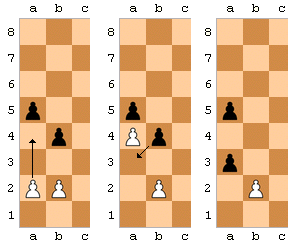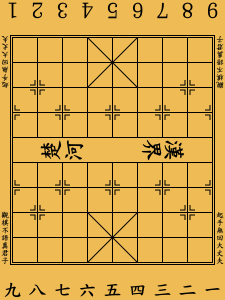In chess, a fork is a tactic in which a piece attacks multiple enemy pieces simultaneously. The attacker usually aims to capture one of the forked pieces. The defender often cannot counter every threat. A fork is most effective when it is forcing, such as when the king is put in check. A fork is a type of double attack.

The rules of chess govern the play of the game of chess. Chess is a two-player abstract strategy board game. Each player controls sixteen pieces of six types on a chessboard. Each type of piece moves in a distinct way. The object of the game is to checkmate the opponent's king; checkmate occurs when a king is threatened with capture and has no escape. A game can end in various ways besides checkmate: a player can resign, and there are several ways a game can end in a draw.

Descriptive notation is a chess notation system based on abbreviated natural language. Its distinctive features are that it refers to files by the piece that occupies the back rank square in the starting position and that it describes each square two ways depending on whether it is from White or Black's point of view. It was common in English, Spanish and French chess literature until about 1980. In most other languages, the more concise algebraic notation was in use. Since 1981, FIDE no longer recognizes descriptive notation for the purposes of dispute resolution, and algebraic notation is now the accepted international standard.
This glossary of chess explains commonly used terms in chess, in alphabetical order. Some of these terms have their own pages, like fork and pin. For a list of unorthodox chess pieces, see Fairy chess piece; for a list of terms specific to chess problems, see Glossary of chess problems; for a list of named opening lines, see List of chess openings; for a list of chess-related games, see List of chess variants; for a list of terms general to board games, see Glossary of board games.
Stalemate is a situation in chess where the player whose turn it is to move is not in check and has no legal move. Stalemate results in a draw. During the endgame, stalemate is a resource that can enable the player with the inferior position to draw the game rather than lose. In more complex positions, stalemate is much rarer, usually taking the form of a swindle that succeeds only if the superior side is inattentive. Stalemate is also a common theme in endgame studies and other chess problems.
Madrasi chess is a chess variant invented in 1979 by Abdul Jabbar Karwatkar. The game uses the conventional rules of chess with the addition that when a piece is attacked by a piece of the same type but opposite colour it is paralysed and becomes unable to move, capture or give check.

The Immortal Game was a chess game played in 1851 by Adolf Anderssen and Lionel Kieseritzky. It was played while the London 1851 chess tournament was in progress, an event in which both players participated. The Immortal Game was itself a casual game, however, not played as part of the tournament. Anderssen won the game by sacrificing all of his major pieces while developing a mating attack with his remaining minor pieces. Despite losing the game, Kieseritzky was impressed with Anderssen's performance. Shortly after it was played, Kieseritzky published the game in La Régence, a French chess journal which he helped to edit. In 1855, Ernst Falkbeer published an analysis of the game, describing it for the first time with its sobriquet "immortal".

The Evergreen Game is a famous chess game won by Adolf Anderssen against Jean Dufresne in 1852.
The zwischenzug is a chess tactic in which a player, instead of playing the expected move, first interposes another move posing an immediate threat that the opponent must answer, and only then plays the expected move. It is a move that has a high degree of "initiative". Ideally, the zwischenzug changes the situation to the player's advantage, such as by gaining material or avoiding what would otherwise be a strong continuation for the opponent.
In chess, a discovered attack is a direct attack revealed when one piece moves out of the way of another. Discovered attacks can be extremely powerful, as the piece moved can make a threat independently of the piece it reveals. Like many chess tactics, they often succeed because the opponent would be unable to meet two threats at once unless one of the attacked pieces can simultaneously move away from its own attack and capture the other attacking piece. While typically the consequence of a discovered attack is the gain of material, they do not have to do this to be effective; the tactic can be used merely to gain a tempo. If the discovered attack is a check, it is called a discovered check.

In chess, en passant describes the capture by a pawn of an enemy pawn on the same rank and an adjacent file that has just made an initial two-square advance. This is a special case in the rules of chess. The capturing pawn moves to the square that the enemy pawn passed over, as if the enemy pawn had advanced only one square. The rule ensures that a pawn cannot use its two-square move to safely skip past an enemy pawn.
In chess and similar games, check is a condition that occurs when a player's king is under threat of capture on the opponent's next turn. A king so threatened is said to be in check. A player must get out of check if possible by moving the king to an unattacked square, interposing a piece between the threatening piece and the king, or capturing the threatening piece. If the player cannot remove the check by any of these options, the game ends in checkmate and the player loses. Players cannot make any move that puts their own king in check.
In chess, a pure mate is a checkmate position such that the mated king is attacked exactly once, and prevented from moving to any of the adjacent squares in its field for exactly one reason per square. Each of the squares in the mated king's field is attacked or "guarded" by one—and only one—attacking unit, or else a square which is not attacked is occupied by a friendly unit, a unit of the same color as the mated king. Some authors allow that special situations involving double check or pins may also be considered as pure mate.
Kriegspiel is a chess variant invented by Henry Michael Temple in 1899 and based upon the original Kriegsspiel developed by Georg von Reiswitz in 1812. In this game, each player can see their own pieces but not those of their opponent. For this reason, it is necessary to have a third person act as an umpire, with full information about the progress of the game. Players attempt to move on their turns, and the umpire declares their attempts 'legal' or 'illegal'. If the move is illegal, the player tries again; if it is legal, that move stands. Each player is given information about checks and captures. They may also ask the umpire if there are any legal captures with a pawn. Since the position of the opponent's pieces is unknown, Kriegspiel is a game of imperfect information.
In chess, a queen sacrifice is a move that sacrifices a queen, the most powerful piece, in return for some compensation, such as a tactical or positional advantage.

Hexagonal chess is a group of chess variants played on boards composed of hexagon cells. The best known is Gliński's variant, played on a symmetric 91-cell hexagonal board.
In chess, a desperado is a piece that is either en prise or trapped, but captures an enemy piece before it is itself captured in order to compensate the loss a little, or is used as a sacrifice that will result in stalemate if it is captured. The former case can arise in a situation where both sides have hanging pieces, in which case these pieces are used to win material prior to being captured. A desperado in the latter case is usually a rook or a queen; such a piece is sometimes also called crazy or mad.
The Falkbeer Countergambit is a chess opening that begins:

In chess, several checkmate patterns occur frequently enough to have acquired specific names in chess commentary. By definition, a checkmate pattern is a recognizable/particular/studied arrangements of pieces that delivers checkmate. The diagrams that follow show these checkmates with White checkmating Black.

The following outline is provided as an overview of and topical guide to chess:










